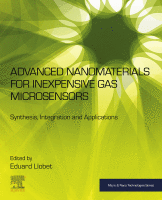Browse content
Table of contents
Actions for selected chapters
- Full text access
- Book chapterAbstract only
Chapter 1 - Introduction
Eduard Llobet
Pages 1-15 - Book chapterAbstract only
Chapter 2 - Inorganic nanomaterials
Francisco Hernandez-Ramirez, Albert Romano-Rodriguez and Joan Daniel Prades
Pages 17-35 - Book chapterAbstract only
Chapter 3 - Molecular materials for gas sensors and sensor arrays
Mariluz Rodriguez-Mendez and José Antonio de Saja
Pages 37-54 - Book chapterAbstract only
Chapter 4 - Carbon nanomaterials
Eduard Llobet
Pages 55-84 - Book chapterAbstract only
Chapter 5 - Hybrid and 2D nanomaterials
Marcel Bouvet
Pages 85-102 - Book chapterAbstract only
Chapter 6 - Fabrication techniques for coupling advanced nanomaterials to transducers
Saleem Khan and Danick Briand
Pages 103-124 - Book chapterAbstract only
Chapter 7 - CMOS-based resistive and FET devices for smart gas sensors
Julian William Gardner and Prasanta Kumar Guha
Pages 125-141 - Book chapterAbstract only
Chapter 8 - Optical devices
Francisco J. Arregui, Jesus M. Corres, ... Ignacio R. Matias
Pages 143-160 - Book chapterAbstract only
Chapter 9 - Resonant microcantilever devices for gas sensing
Hélène Debéda and Isabelle Dufour
Pages 161-188 - Book chapterAbstract only
Chapter 10 - Advanced operating methods
Janusz Smulko
Pages 189-208 - Book chapterAbstract only
Chapter 11 - Indoor air quality monitoring
Andreas Schütze and Tilman Sauerwald
Pages 209-234 - Book chapterAbstract only
Chapter 12 - Low-cost sensors for outdoor air quality monitoring
Michele Penza
Pages 235-288 - Book chapterAbstract only
Chapter 13 - Monitoring perishable food
Luis Fonseca and Carles Cané
Pages 289-314 - Book chapterAbstract only
Chapter 14 - Point of care breath analysis systems
Haitham Amal and Hossam Haick
Pages 315-334 - Book chapterAbstract only
Chapter 15 - Concluding remarks and outlook
Eduard Llobet
Pages 335-346 - Book chapterNo access
Index
Pages 347-357
About the book
Description
Advanced Nanomaterials for Inexpensive Gas Microsensors: Synthesis, Integration and Applications presents full coverage in the area of gas sensing nanomaterials, from materials, transducers and applications, to the latest results and future direction. Experts present work on metal oxides, carbon-based and hybrid materials, fabrication and application. The book brings together three major themes, including synthesis, functionalization and the characterization of advanced nanomaterials, all emphasizing synthesis techniques that ease the integration of nanomaterials in transducers. Chapters encompass a wide spectrum of sensing technologies, including advanced nanomaterials (metal oxides, carbon materials and graphene) and organic molecular materials and atomic layers (MoS2).
The book's authors examine the coupling of sensitive nanomaterials to different types of transducer elements and their applications, including direct growth and additive fabrication techniques as a way to obtain inexpensive gas microsensors, principal transduction schemes, and advanced operating methods.
Advanced Nanomaterials for Inexpensive Gas Microsensors: Synthesis, Integration and Applications presents full coverage in the area of gas sensing nanomaterials, from materials, transducers and applications, to the latest results and future direction. Experts present work on metal oxides, carbon-based and hybrid materials, fabrication and application. The book brings together three major themes, including synthesis, functionalization and the characterization of advanced nanomaterials, all emphasizing synthesis techniques that ease the integration of nanomaterials in transducers. Chapters encompass a wide spectrum of sensing technologies, including advanced nanomaterials (metal oxides, carbon materials and graphene) and organic molecular materials and atomic layers (MoS2).
The book's authors examine the coupling of sensitive nanomaterials to different types of transducer elements and their applications, including direct growth and additive fabrication techniques as a way to obtain inexpensive gas microsensors, principal transduction schemes, and advanced operating methods.
Key Features
- Presents technological solutions and applications of gas sensors in varied areas of chemistry, physics, material science and engineering
- Examines advanced operating methods (e.g., temperature modulation, self-heating, light-activated response, noise methods) to enhance stability, sensitivity, selectivity and reduce power consumption
- Provides a critical review of current applications and their expected future evolution, demonstrating the most promising approaches and future expectations in the development of inexpensive gas micro- and nanosensors
- Presents technological solutions and applications of gas sensors in varied areas of chemistry, physics, material science and engineering
- Examines advanced operating methods (e.g., temperature modulation, self-heating, light-activated response, noise methods) to enhance stability, sensitivity, selectivity and reduce power consumption
- Provides a critical review of current applications and their expected future evolution, demonstrating the most promising approaches and future expectations in the development of inexpensive gas micro- and nanosensors
Details
ISBN
978-0-12-814827-3
Language
English
Published
2019
Copyright
Copyright © 2020 Elsevier Inc. All rights reserved.
Imprint
Elsevier
